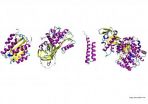(Press-News.org) DURHAM, N.C. – Just as horses shake off pesky flies by twitching their skin, ships may soon be able to shed the unwanted accumulation of bacteria and other marine growth with the flick of a switch.
Duke University engineers have developed a material that can be applied like paint to the hull of a ship and will literally be able to dislodge bacteria, keeping it from accumulating on the ship's surface. This buildup on ships increases drag and reduces the energy efficiency of the vessel, as well as blocking or clogging undersea sensors.
The material works by physically moving at the microscopic level, knocking the bacteria away. This avoids the use of bacteria-killing paints, which can contain heavy metals or other toxic chemicals that might accumulate in the environment and unintentionally harm fish or other marine organisms.
The Duke researchers also say that similar types of materials could be used in other settings where the buildup of bacteria – known as biofilms -- presents problems, such as on the surfaces of artificial joint implants or water purification membranes.
"We have developed a material that 'wrinkles,' or changes it surface in response to a stimulus, such as stretching or pressure or electricity," said Duke engineer Xuanhe Zhao, assistant professor in Duke's Pratt School of Engineering. "This deformation can effectively detach biofilms and other organisms that have accumulated on the surface."
The results of the Duke studies were published online in the journal Advanced Materials.
Zhao has already demonstrated the ability of electric current to deform, or change, the surface of polymers.
"Nature has offered many solutions to deal with this buildup of biological materials that we as engineers can try to recreate," said Gabriel López, professor of biomedical engineering and mechanical engineering and materials science. He also serves as director of Research Triangle Materials Research Science and Engineering Center (MRSEC), which is funded by the National Science Foundation.
"For example, the hair-like structures known as cilia can move foreign particles from the lungs and respiratory tract," Lopez said. "In the same manner, these types of structures are used by mollusks and corals to keep their surfaces clean. To date, however, it is been difficult to reproduce the cilia, but controlling the surface of a material could achieve the same result."
The researchers tested their approach in the laboratory with simulated seawater, as well as on barnacles. These experiments were conducted in collaboration with Daniel Rittschof the Duke University Marine Lab in Beaufort, N.C.
Keeping bacteria from attaching to ship hulls or other submerged objects can prevent a larger cascade of events that can reduce performance or efficiency. Once they have taken up residence on a surface, bacteria often attract larger organisms, such as seaweed and larva of other marine organisms, such as worms, bivalves, barnacles or mussels.
"It is known that bacterial films can recruit other organisms, so stopping the accumulation process from the beginning in the first place would make a lot of sense," Lopez said.
INFORMATION:
The project is funded by the U.S. Office of Naval Research and the MRSEC. Other members of the Duke team are Phanindhar Shivapooja, Qiming Wang and Beatriz Orihuela.
Novel materials shake ship scum
2013-01-31
ELSE PRESS RELEASES FROM THIS DATE:
Biologistics: How fast do chemical trains move in living cells?
2013-01-31
The rate of chemical processes in cells is dictated by the speed of movement (diffusion) of molecules needed for a given reaction. Using a versatile method developed at the Institute of Physical Chemistry of the Polish Academy of Sciences in Warsaw, researchers were able to predict for the first time the diffusion coefficients of all proteins in Escherichia coli. The achievement is important not only for biologists and chemists, but also for... transport companies.
Understanding of chemical foundations of life requires knowledge about the rate of chemical reactions in ...
24 new species of flower fly have been found in Central and Southern America
2013-01-31
A team of scientists have described twenty four new species of dipterans belonging to Quichuana genus, of which only a further 24 species were known. The researchers, including two Spanish biologists, have been studying the forests of Central and Southern America for ten years and they have now published their results in the 'Zoological Journal of the Linnean Society'.
A ten-year study in forests of the American continent has resulted in the description of 24 new insect species from the Quichuana genus that are also known as 'flower flies'.
Up until now only a further ...
Rehabilitation therapies can lead to recovery from chronic fatigue syndrome
2013-01-31
Research led by Queen Mary, University of London, has shown that recovery from chronic fatigue syndrome (CFS) is possible for some patients, and has identified two treatments most likely to lead to recovery.
The latest results from the PACE trial* show that cognitive behaviour therapy (CBT) and graded exercise therapy (GET), as supplements to specialist medical care, increase the likelihood of recovery from CFS three-fold compared to other treatments studied. The trial, carried out in collaboration with researchers from King's College London, the University of Oxford ...
The humble 'virtual chimney' fences that could reduce the impact of airport pollution
2013-01-31
Simple 'blast' fences called baffles could deliver improvements in air quality for people living near airports, new research has found.
Placed behind a runway, the baffles could serve as a 'virtual chimney', funnelling emissions from aircraft engines upwards where they can disperse more effectively, thereby reducing the environmental impact on people living nearby.
Prototype baffles have been tested by a team of researchers from Manchester Metropolitan University, Cranfield University, University of Southampton and the University of Cambridge, with funding from the ...
Disulfiram: New support for an old addiction drug
2013-01-31
Philadelphia, PA, January 31, 2013 – Disulfiram was the first medication approved for the treatment of alcoholism over 50 years ago. It works, at least in part, by preventing the metabolism of an alcohol by-product, acetaldehyde. High levels of acetaldehyde in the body quickly cause unpleasant symptoms, including nausea, vomiting, headache, and accelerated heart rate. Thus, disulfiram provides a very strong incentive to avoid drinking.
Beginning in the late 1990s, a series of studies conducted at Yale University found that disulfiram reduced the consumption of cocaine, ...
Protein origami: Quick folders are the best
2013-01-31
Proteins are elementary building blocks of life. They often perform vital functions. In order to become active, proteins have to fold into three-dimensional structures. Misfolding of proteins leads to diseases such as Alzheimer's or Creutzfeld-Jakob. So which strategies did nature develop over the course of evolution to improve protein folding?
To examine this question, the chemist Dr. Frauke Gräter (Heidelberg Institute for Theoretical Studies) looked far back into the history of the Earth. Together with her colleague Prof. Gustavo Caetano-Anolles at the University of ...
A possible answer for protection against chemical/biological agents, fuel leaks, and coffee stains
2013-01-31
A recent discovery funded by the Air Force Office of Scientific Research (AFOSR) may very well lead to a process that not only benefits every uniformed service member of the Department of Defense, but everyone else as well: protection from Chemical/Biological agents, to self-cleaning apparel, to effortless thermal management, to fuel purification as well as enhanced control of leaks—especially oil and fuels.
In 2006, AFOSR Program Manager Dr. Charles Lee funded Professor Gareth McKinley at the Massachusetts Institute of Technology exploring nanocomposite technology ...
Second-generation CT scanner substantially reduces radiation exposure
2013-01-31
OAK BROOK, Ill. (January 31, 2013) – Researchers using a newly approved advanced computed tomography (CT) system were able to significantly reduce radiation exposure in patients undergoing coronary CT angiography (CCTA), according to a new study published online in the journal Radiology.
"Radiation exposure during diagnostic imaging is a substantial public concern," said Marcus Y. Chen, M.D., lead author of the study from the advanced cardiovascular imaging laboratory at the National Institutes of Health in Bethesda, Md. "Minimizing radiation exposure while maintaining ...
Corn cobs eyed for bioenergy production
2013-01-31
This press release is available in Spanish.
Corn crop residues are often left on harvested fields to protect soil quality, but they could become an important raw material in cellulosic ethanol production. U.S. Department of Agriculture (USDA) research indicates that soil quality would not decline if post-harvest corn cob residues were removed from fields.
This work, led by Agricultural Research Service (ARS) soil scientist Brian Wienhold, supports the USDA priority of developing new sources of bioenergy. ARS is USDA's chief intramural scientific research agency.
Wienhold ...
Gum disease found to worsen infection in animal model of AIDS
2013-01-31
Texas Biomed scientists in San Antonio have found that moderate gum disease in an animal model exposed to an AIDS- like virus had more viral variants causing infection and greater inflammation. Both of these features have potential negative implications in long term disease progression, including other kinds of infections, the researchers say in a new report.
The public health message from the study is that even mild inflammation in the mouth needs to be controlled because it can lead to more serious consequences, said Luis Giavedoni, Ph. D, a Texas Biomed virologist and ...



